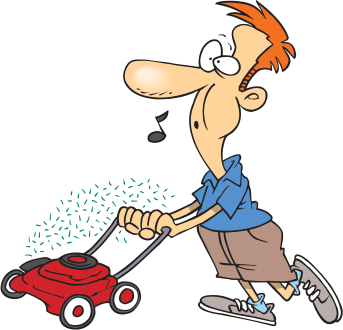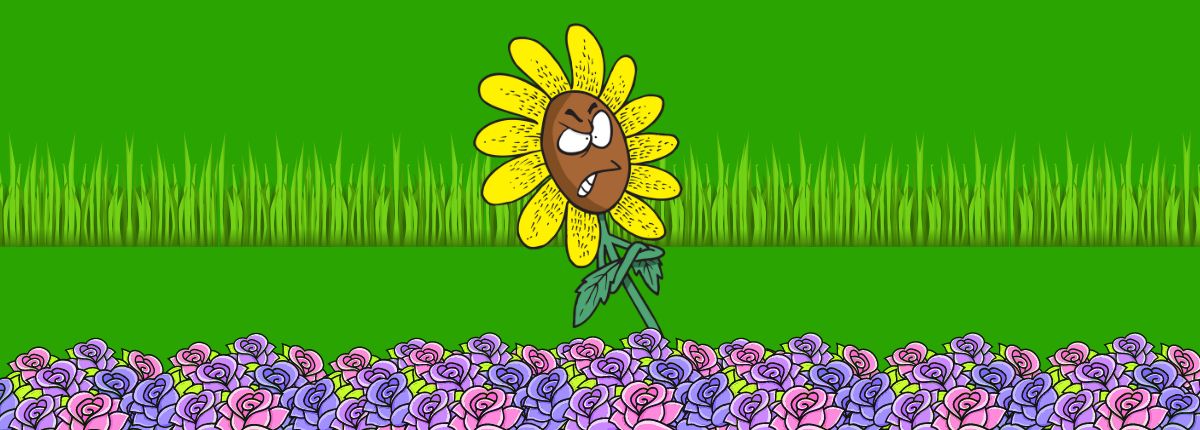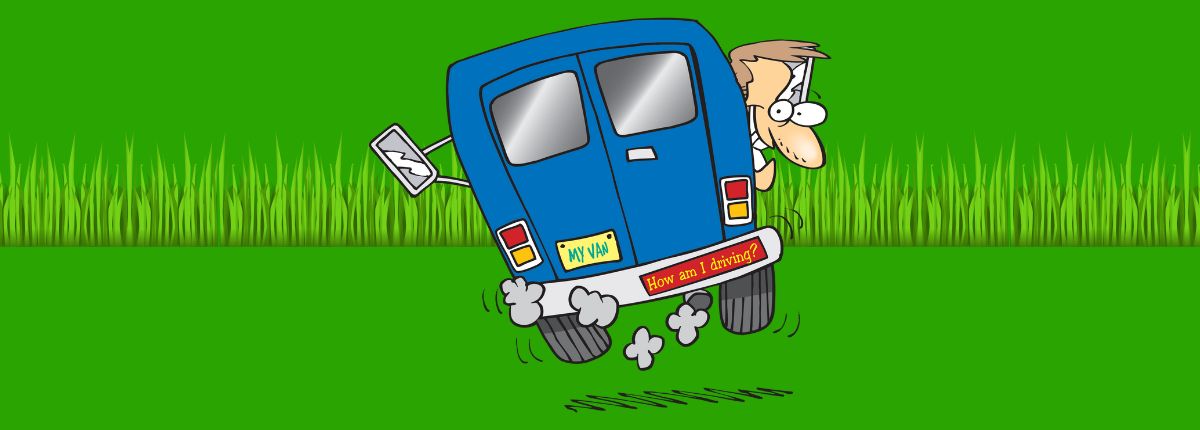Why Your Lawn Is Growing at Different Rates.
Table of Contents
Don’t you hate it when you look at your lawn and it needs mowing? Worse still. It’s just a bit in the middle that grows like that and makes the whole lawn look shabby.
Or maybe you have the opposite problem. You have a place on your lawn where you just cannot get the grass to grow. You have tried everything and still, have the proverbial bald spot on your lawn
Well, fear not. You have come to the right place. After thirty years in the industry, I find these are the most common problems and how to fix them.
Reasons why a lawn is growing at different rates
If you have some areas of your lawn growing faster than others the main reason will be one of the following issues.
- Different kinds of grass
- Using a different grass seed
- Uneven spreading of fertilizer
- Poor aeration
- Different soils
- A septic tank or water leak
- Disease – Red Thread
- Water (or lack of it)
- Sunlight (direct vs shade)
- Dog pee
- Mower ruts
- You are cutting your lawn too short.
There is a high chance that one of these issues is the cause of your problem. I will list the symptoms and the cures and all you need to do is go through them and rule out each one until you find the culprit. This list runs from the most common to the uncommon so you can track your issue down quicker.
This could be fun.
When you have eliminated the impossible, whatever remains, however improbable, must be the truth
Causes, symptoms, and solutions.
You may have more than one kind of grass on your lawn.
Depending on where you live there are different kinds of grasses you may have. Go out and have a close look at your lawn.
- Is the grass the same all over or is it two different kinds of grass?
- Is some of the grass on your lawn actually a weed?
- Does your lawn look like it’s a mixed-seed lawn?
If any of these is the case, the best way to proceed would be to mow your lawn more often. Try catching the thicker areas and munching the shorter areas.
It would also be a good idea to use a weed and feed spray on the lawn going lightly on the thick areas and heaver on the thin areas. You can find a good weed and feed mixture at your local hardware shop or you can buy one that I would recommend on Amazon.
If you keep up with the mowing and mulching with the occasional weed and feed you should start to see a difference in your lawn.
Was the lawn reseeded recently?
If a lawn was patchy and then overseeded then that could be the issue. The photo above is a new lawn that grew weeds within the first twelve months, the owner dug out the weeds and overseeded the dirt areas.
The issue was that it was a different type of grass which caused the grass to grow unevenly.
This newly seeded lawn will not be easy to fix. For the best results when overseeding you should always reseed the entire lawn not just some areas.
Was the lawn fertilized recently?
If so read on. If not you can rule this one out and move on to poor aeration.
Did you spread by hand or did you use a spreader?
If you fertilized by hand then you may have gone a bit heavy in some areas. You will be able to see this because the throw pattern will show in the fast-growing areas.
The next time you fertilize use a spreader as this will give you a lot more even coverage. You can get a spreader at your local hardware store or you can use a Scotts spreader that I like on Amazon.
If you can see lines where the grass is growing faster then that is an easy fix. In the future try to put a bit more distance between the rows when dispensing the fertilizer.
A spreader or adjusting your throw, or distance on the spreader should solve that problem along with lots of regular mowing,
Lawnmowing101 Membership

Build a six-figure lawn care business
Lawn Care Software

Get Your Lawn Care Business Running Smoothly
Easier for you and your customers. Jobber helps you quote, schedule, invoice, and get paid—all in one place.
How do I know if my lawn has poor aeration?
One simple test you can do with your lawn to determine if poor aeration is an issue is to stab a few of the slow-growing areas where the grass is growing unevenly with a garden fork and then water them or wait for rain. If the grass starts to green up and grow then bad aeration is an issue.
What is bad aeration?
Bad aeration is basically a lack of water getting through to the soil. The most common cause of this is soil compaction or lawn thatch.
Soil compaction
This can be caused by runoff of water which pools on the ground when it rains. The water pools instead of draining and as it pools it compresses the air and moisture out of the soil. This hardens the soil and makes it hard for the grass to grow. Therefore creating smaller less healthy plants.
Action required – You need to aerate the lawn. You could aerate the soil using a Spike Aerator (usually found at your local home improvement store), or you can find them on Amazon. See the video below for an explanation of aeration and why you should do it.
Soil compaction effects on turf are covered in more depth in this article
Thatching
– This happens when the dead grass builds up into a layer on top of the soil stopping air from circulating around the roots or water from reaching the soil. You can usually spot thatching by digging into the grass with your finger. If there is a thick layer of dead grass and it feels spongy then it is thatched.
Action required – You need to dethatch your lawn. You could either pay a contractor or hire a dethatching machine. A cheaper method that works quite well is to use a dethatching rake. This is a rake that is designed to remove the thatching while leaving the grass intact.
Have you got different soil types?
If you have different types of soil in areas of your lawn this can cause uneven growth.
Clay
One of the most common reasons for a change of soil type is if you have had building or landscaping done in the past and clay has been brought to the surface and left.
Action required – If you don’t want to go all out and replace the top six inches of topsoil here there are a few things you could do. You may not see good results for a couple of seasons but it will save you digging up your lawn.
Firstly you will need to aerate the clay. Do this when the clay is moist, not wet. Then top-dress your lawn with a mixture of loam, peat, and sand and finish off by mowing your lawn with a mulching mower (or without a catcher) in that area in the future. This should improve the soil over time.
A buried Septic tank.
Another thing that can affect the quality of the soil and produce fast-growing areas is a leaking or old septic tank. The giveaway for this is usually the fast-growing grass is in some kind of symmetrical pattern.
Action required – Unless there is a leak that can be fixed there is nothing you can do, although you could fertilize the rest of the lawn and leave this area alone. This should even out the growth somewhat.
A water leak
A fast-growing piece of lawn in one specific area can be an indication of a water leak. If there is a leak the area will be soft and spongy.
Action required – You will need to dig down and repair the pipe. If this is not within your skillset you will need to get a plumber to do the job.
Red thread
If there appear to be slow-growing or dying patches in your lawn and there is a reddish tinge in those areas you have a lawn disease called “Red Thread”. This disease is a fungus and can be spread with a lawnmower. It lives in the thatch area and can come back year after year.
Action required – A top dressing with a fertilizer that contains nitrogen will help. As the nitrogen absorbs into the soil when it rains the disease may grow. Here is a video that will help you understand why this issue occurs and how to treat it.
Uneven watering.
If you use a sprinkler system make sure all the heads are working. A blocked sprinkler head can reduce the amount of water in an area of a lawn and cause uneven growth.
Is the slow-growing area in the shade?
If there is a lack of sunlight for most of the day then the lawn then you will never get a lush lawn but it can be improved by using lawn fertilizer on a regular basis. Pruning some of the surrounding trees may help in getting more sunlight on the lawn.
Dog urine
If you have a four-legged friend of the K9 verity then you may not need to look any further for the culprit.
There is a product called Dog Rocks that you put in your dog’s drinking water and it neutralizes their urine. I have never tried it myself with my dog but I find the idea interesting.
Mower Ruts.
When I have been out mowing lawns I have seen from time to time slow-growing grass due to mower ruts. This is usually because the lawn is a certain shape that causes you to mow it the same way every time. You need to change the direction you are mowing the lawn on a regular basis to address this issue. It also wouldn’t hurt to mow without a catcher for a while.
If the ruts are uniform it could be that your axel Bushes are worn. This will cause the mower to cut lower on one side and give an uneven cut leading to uneven growth. You can test this by trying to move your wheel up and down. If there is lots of movement you will probably need new bushes.
A cut like this may be caused by a worn axle or barring.
One last way to get uneven growth on your lawn is to cut the grass too short. If you cut the lawn you can kill the crown of the grass. This will restrict the growth of new chutes and encourage flat weeds. Never cut any more than 1/3 off the height at any given time. This will encourage a healthy lawn that requires little maintenance.
To sum up
I hope that this has helped you diagnose your problem and take steps toward fixing it.
Listen to audiobooks while you work.

With a sixty-day free trial
Discover millions of ebooks, audiobooks, and so much more for just $9.99/month.
You may also like
Get tips & tricks on how to grow a profitable lawn care business delivered to you inbox every week.






Leave a Reply